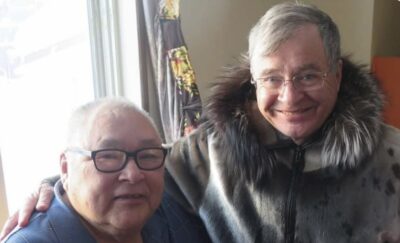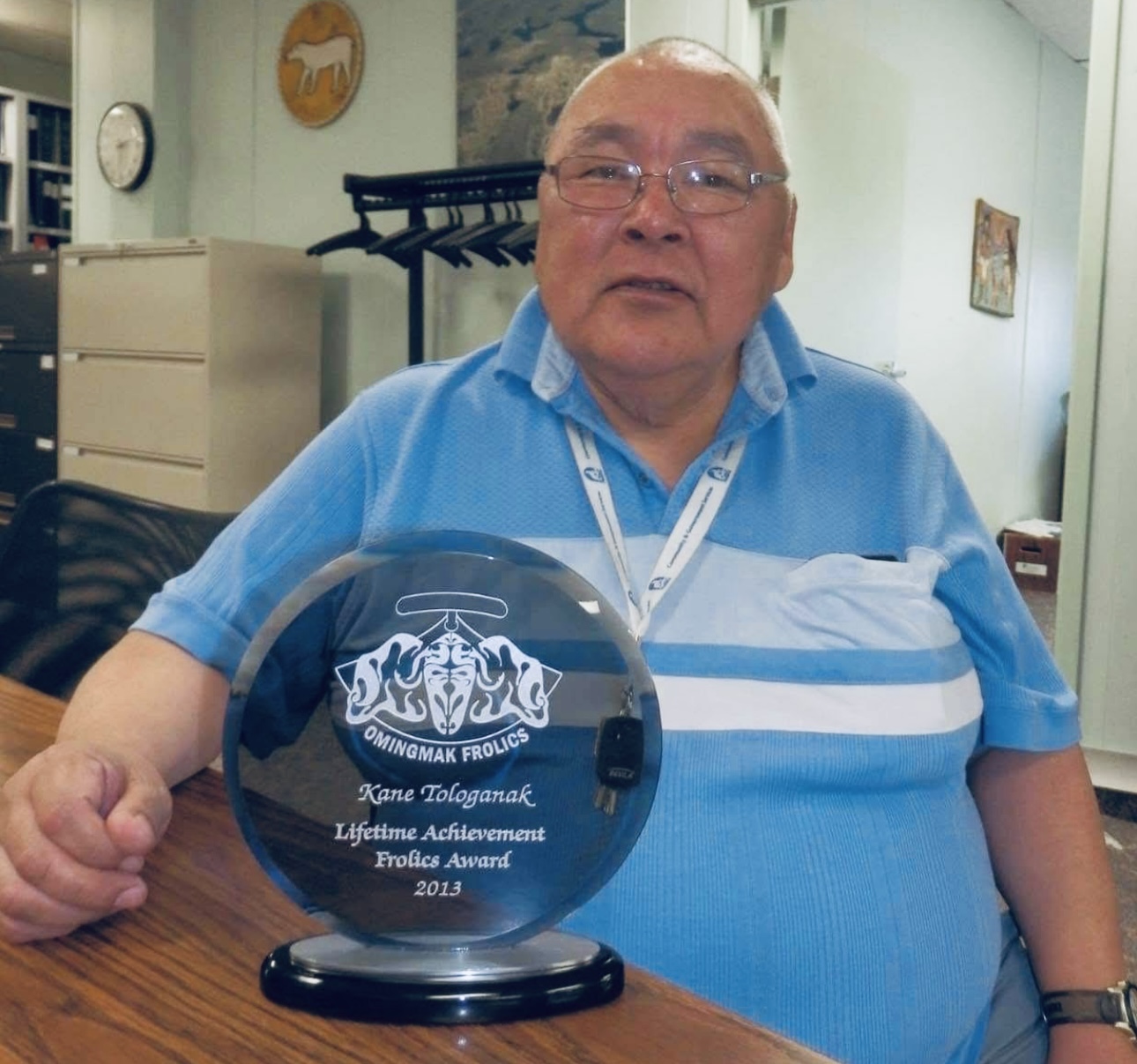Born in a pitched tent in the N.W.T., Kane Tologanak rose to be cabinet minister
Arctic Matters | Former senator pays tribute to Inuit leader who helped pave the way to creation of Nunavut
Former N.W.T. leader Kane Tologanak poses with a lifetime achievement award from the Omingmak Frolics. The longtime politician died in Gjoa Haven on March 23. (Photo courtesy of Dennis Patterson)

Dennis Patterson
Back in 1979, in Northwest Territories days, there was an election that changed the composition of the N.W.T.’s 22-member legislature. For the first time, a majority of MLAs were Indigenous.
That 9th Assembly included prominent Indigenous leaders like Nellie Cournoyea, who led the Inuvialuit to the first major territorial land claim settlement; Dene leaders James Wah-Shee, Richard Nerysoo and Nick Sibbeston, the latter two who became N.W.T. premiers; and from the Eastern Arctic, Tagak Curley, the founding president of Inuit Tapirisat of Canada and a passionate advocate for Nunavut.
The 10 members of the 22-member assembly from the Eastern Arctic, including Nellie Cournoyea, representing their Inuvialuit brothers and sisters, quickly organized into a “Nunavut caucus” and declared an intention to boycott the historically western-N.W.T. dominated cabinet.
They instead formed a “shadow cabinet,” which would, in an organized way, promote division of the N.W.T. and the creation of Nunavut while also acting as a constructive critic of the western-dominated cabinet.
Two years later in 1981, following a mid-term review, two vacancies arose in cabinet. The premier at the time, George Braden (whose title then was leader of the elected executive), asked the Nunavut caucus to nominate two of its members to represent the Eastern Arctic and fill the two vacancies.
Most of our colleagues from what is now Nunavut did not want to have to move to Yellowknife and be far away from their homes and families to be cabinet ministers, so Kane Tologanak and I agreed to represent the Nunavut caucus in cabinet.

Former N.W.T. cabinet minister Kane Tologanak, left, poses with former Nunavut senator Dennis Patterson. (Photo courtesy of Dennis Patterson)
Kane made his mark right away. As the first cabinet minister from the Kitikmeot, he persuaded cabinet to have the region established as a new standalone region deserving of its own regional centre — Cambridge Bay — and its own regional director.
Previously, the Kitikmeot communities were administered remotely from the regional headquarters in far-off Fort Smith. This was a huge boost for bringing territorial government services closer to home and more responsive to the unique needs of the largely Inuit population on the Arctic Coast.
Kane first became minister of supply and services. Working with John Quirke as his deputy minister, who later became the longtime (and recently retired) first clerk of the Nunavut legislative assembly, Kane developed the first “Business Incentive Policy” to give northern businesses an advantage in bidding on territorial government contracts.
That policy has now morphed into the Nunavummi Nangminiqaqtunik Ikajuuti (NNI) policy, giving preference to Inuit and northern businesses under the Nunavut Land Claims Agreement. But it was Kane Tologanak who started that new direction to support northern businesses back in 1981.
Later, Kane became minister of health and pioneered the first step in the eventual transfer of health services from the federal department of national health and welfare to the Northwest Territories government, when he persuaded then-federal health minister Monique Begin to transfer running the Baffin Regional Hospital to serve the region through a regional board of directors.
That first step paved the way for the territorial government to take over all health services in the N.W.T. from the federal government in the mid-1980s.
Kane’s parents worked on the Distant Early Warning line and with the RCMP. He tells the story of his dad and his pregnant mother being on patrol with an RCMP dog team heading to Cambridge Bay to give birth to him, but they didn’t make it on time. So Kane, the first of 10 children, was born in a quickly pitched tent on the land at the West Arm near Cambridge Bay.
It was there that Kane got his first name from the RCMP who assisted with his birth — after the Arctic explorer Elisha Kane. His parents also worked on other DEW line sites, including at Fox Main near Sanirajak, where Kane remembers eating walrus meat as a young boy.
Kane and Elik have a large extended family who fondly call them mom and dad, as they always cared for them throughout their lives as their own children, mentoring them and giving them advice.
Kane passed away on March 24 in Gjoa Haven at the age of 75 and is survived by his wife Elik and their children Jessie, Calvin, Lynn, and John Paul, and seven grandchildren.
I salute Kane, for his dedication to the cause of creating Nunavut and for the important changes he made in government.
The Hon. Dennis Patterson represented Nunavut in the Senate from 2008 to 2023. He was premier of the Northwest Territories from 1987 to 1991, and played a key role in the Nunavut land claim agreement.






Some further notes on Kane Tologanak’s passing. Kane died peacefully Monday night March 24. He is survived by his wife of 51 years, Elik, and his children: Jessie, Calvin, and Lynn. Their adopted son John Paul predeceased Kane in 2009. Kane and Elik’s grandchildren are Lloyd, Megan, Kolby, James, Dallas, Thomas and Maurice and their great grandchildren are Gina and Esther. April 1, 2025 will mark the 44th year since the establishment of the Kitikmeot Region on April 1, 1981. Funeral services for Kane Tologanak will be held Tuesday April 8, 2025 at 2 p.m. in Cambridge Bay.